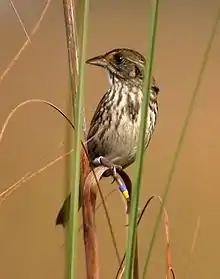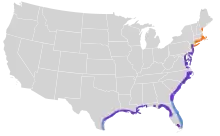Seaside sparrow
The seaside sparrow (Ammospiza maritima) is a small American sparrow.
| Seaside sparrow | |
|---|---|
 | |
| Cape Sable seaside sparrow in Everglades National Park | |
| Scientific classification | |
| Kingdom: | Animalia |
| Phylum: | Chordata |
| Class: | Aves |
| Order: | Passeriformes |
| Family: | Passerellidae |
| Genus: | Ammospiza |
| Species: | A. maritima |
| Binomial name | |
| Ammospiza maritima (Wilson, 1811) | |
| Subspecies | |
|
Ammospiza maritima mirabilis | |
 | |
Adults have brownish upperparts with gray on the crown and nape, and a grayish-buff-colored breast with dark streaks; they have a dark face with gray cheeks, a white throat, and a short, pointed tail. Birds show a small yellow streak just above the eye.
Their breeding habitat is salt marshes on the Atlantic and Gulf coasts of the United States from southern New Hampshire to southern Texas. The nest is an open cup usually built in the salt marsh on tidal reeds and spartina grasses. Females lay two to five eggs.
Northern birds most often migrate farther south along the eastern coast of the United States. They forage on the ground or in marsh vegetation, sometimes probing in mud. They mainly eat insects, marine invertebrates and seeds. Their feeding areas are often some distance away from the areas they choose to nest.
One of the numerous subspecies of this bird, the dusky seaside sparrow (A. m. nigrescens), has recently become extinct, and the Cape Sable subspecies, A. m. mirabilis, is endangered. Occurring in a restricted range but of uncertain validity is Scott's seaside sparrow, (A. m. peninsulae). Those were formerly considered a separate species.
The song is a raspy buzz that closely resembles a distant red-winged blackbird.
References
- BirdLife International (2018). "Ammospiza maritima". IUCN Red List of Threatened Species. 2018. Retrieved 1 June 2020.CS1 maint: ref=harv (link)
External links
| Wikimedia Commons has media related to the seaside sparrow. |
| Wikispecies has information related to Ammodramus maritimus. |
- "Seaside sparrow media". Internet Bird Collection.
- Stamps (for the United States) with a range map at bird-stamps.org
- Seaside sparrow photo gallery at VIREO (Drexel University)
- Dusky seaside sparrow bird sound at the Florida Museum of Natural History
- Cape Sable seaside sparrow bird sound at the Florida Museum of Natural History
- "Ecological and Genetic Diversity in the Seaside Sparrow" (pdf, 0.95 Mb)
- Interactive range map of Ammodramus maritimus at IUCN Red List maps
